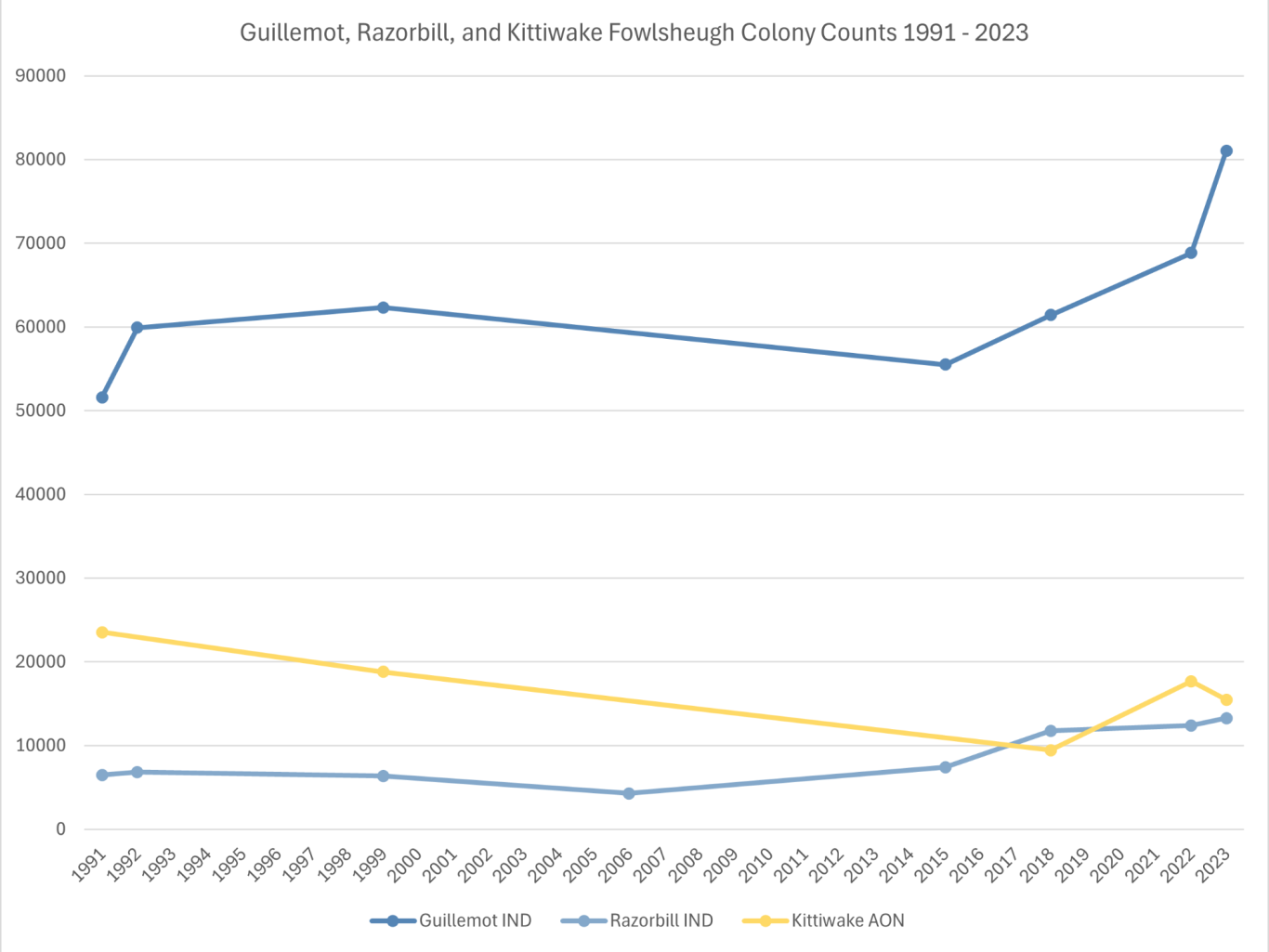www.stateofthecoast.scot
Fowlsheugh Cliffs
Key Findings
The Fowlsheugh cliffs are located around 5km south of Stonehaven (Fig. 1), and are home to one of the largest seabird colonies in mainland Britain. Fowlsheugh is managed by the RSPB. The cliffs are sheer, ranging between 30-60m in height, with the underlying rock consisting of basalt and conglomerate of Old Red Sandstone age (NatureScot, 2011).
Fowlsheugh supports over 115,000 breeding seabirds every year (RSPB, n.d.), with some of these breeding populations being nationally and internationally important. For example, Fowlsheugh regularly supports 5% of the GB population and 1.7% of the Western European population of common guillemot (Uria aalge) (Fig. 2), alongside 7.5% of the GB population and 1.2% of the World population of black-legged kittiwake (Rissa tridactyla) (NatureScot, 2009). Fig. 3 shows the full colony counts for common guillemot, razorbill (Alca torda), and black-legged kittiwake.
The cliffs also support various plants such as thrift (Armeria maritima), gorse (Ulex europaeus), and yarrow (Achillea millefolium). Butterflies recorded at the site include small tortoiseshell (Aglais urticae), northern brown argus (Aricia artaxerxes), small copper (Lycaena phlaeas), and meadow brown (Maniola jurtina).
There is a level of pressure on the cliffs from recreation, with walkers and wildlife watchers visiting Fowlsheugh to see the seabirds and the landscape. This can have an impact on the clifftop vegetation and also potentially disturb breeding birds. Highly Pathogenic Avian Influenza has impacted upon the breeding seabirds at Fowlsheugh, particularly guillemots and kittiwakes (SOC North East Scotland Branch, n.d.).
Conservation Designations:
Fowlsheugh is designated a Site of Special Scientific Interest (SSSI) for breeding fulmar (Fulmarus glacialis), common guillemot, black-legged kittiwake, razorbill, puffin (Fratercula artica), and the seabird colony as a whole (NatureScot, 1983). Fowlsheugh is also designated a Special Protection Area (SPA) for breeding fulmar, guillemot, kittiwake, razorbill, herring gull (Larus argentatus), and the seabird assemblage as a whole (NatureScot, 2009) (Fig. 4).

Figure 1: (Charlotte Tomlinson) Fowlsheugh cliffs

Figure 2: (Charlotte Tomlinson) - Breeding guillemots (Uria aalge) at Fowlsheugh cliffs, 2021.

Figure 3: Seabird counts at RSPB Fowlsheugh - collated from North East Scotland Bird Reports and Tremlett et al (2024)

Figure 4: Fowlsheugh SSSI and SPA boundaries
Notes
None
Linked Information Sheets
Key sources of Information
Reviewed on/by
Status
Live - next update 14/02/2027
To report errors, highlight new data, or discuss alternative interpretations, please complete the form below and we will aim to respond to you within 28 days
Contact us
Telephone: 07971149117
E-mail: ian.hay@stateofthecoast.scot
We need your consent to load the translations
We use a third-party service to translate the website content that may collect data about your activity. Please review the details in the privacy policy and accept the service to view the translations.

